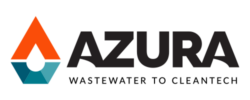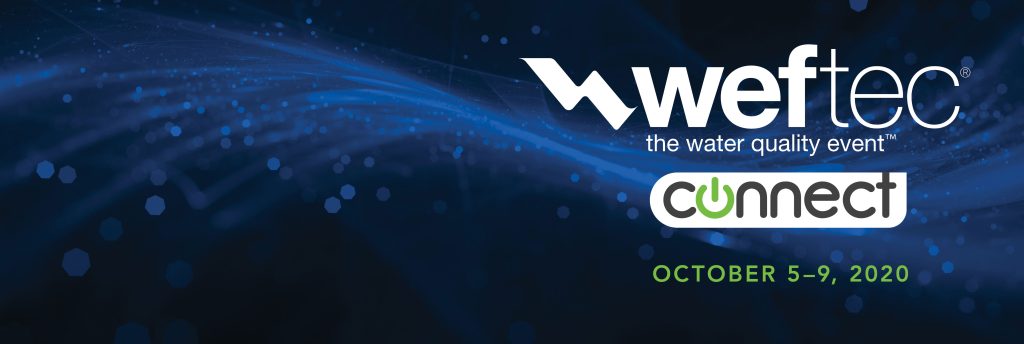Lessons learned from three years of working with full-scale anaerobic codigestion facilities were compiled and shared by Azura’s Dodge Yu and David Ellis at the virtual WEFTEC 2020 conference. Dodge gave the presentation which summarized the observations, data gathered, and lessons learned during Azura’s years of working with farm-based anaerobic codigestion facilities in Ontario, Canada.
This presentation hopes to help inform practitioners striving to make older wastewater treatment plants (WWTPs) into modern water resource recovery facilities (WRRFs). In the new paradigm, WRRFs can be energy generating assets for a municipality, largely achieving a net-zero energy footprint through anaerobic codigestion of food waste with the sewage biosolids to produce biogas and a nutrient-rich fertilizer product.
Azura’s Principal Engineer, David Ellis, recalling his first WEFTEC attendance in Toronto, Canada in 1991 points out “This was a milestone accomplishment for Dodge. His first abstract submitted to WEFTEC was accepted! I hope Dodge continues to share his expertise and experience with others throughout his career.”
WEFTEC is the annual conference and exhibition organized by the Water Environment Federation (WEF). WEF was founded in 1928, and with over 35,000 members and 75 regional member associations, it is the leading international organization for wastewater industry professionals around the world. The annual WEFTEC conference draws over 30,000 attendees every year.
Both David and Dodge were disappointed not to be attending WEFTEC 2020 in person in New Orleans. Dodge was looking forward to attending his first WEFTEC, meeting many of his professional colleagues, learning from world renowned wastewater and anaerobic digestion subject matter experts, and of course, experiencing the in-person crowd and atmosphere. Under the extenuating circumstance caused by the COVID-19 pandemic, WEF decided to go fully virtual for their WEFTEC 2020 conference. Dodge was still able to present Azura’s experience and all the technical presentations were uploaded to the conference site. The presentation titled “Lessons and Experiences from Three Years of Monitoring Energy Digesters” was accepted as part of the “Opportunities, Challenges, and Impacts of Co-digestion with Source Separated Organics” section of the technical sessions.
Over the past years, the Azura team has been working extensively with many of the farm-based and market anaerobic digesters in Ontario and gathered broad operating knowledge and ‘dirty boots’ experience at those facilities.
The Ontario farm-based digesters differ from location to location, but they share some common characteristics. Almost all of these digesters are operated in the mesophilic temperature range, using either single or double digester configurations. These digesters codigest a combination of dairy or other livestock manure with off-farm food waste or organic waste. The resulting digestate slurry is ultimately land-applied on agricultural land. These anaerobic digesters use the biogas generated to produce renewable electricity under the Ontario feed-in-tariff (FIT) program.
The presentation was broken down into three main areas of plant operation: 1) raw material receiving and storage, 2) digester operation and monitoring, and 3) considerations for digestion end-products.
Azura observed some challenges with the raw material receiving areas at client anaerobic digester sites. The most common challenge was due to the nature of the off-farm organic feedstock, which was treated as a waste material by the source location. As a waste product, the composition and characteristics of the material was highly variable. This waste quality also resulted in challenges transporting and storing these off-farm feedstock materials, which could cause significant disruption to digester operations.
Commonly used on-site digester monitoring parameters include biogas composition, digestate pH, and a titration to estimate the ratio of the volatile organic acids to the alkalinity present in the digester. Some digesters use the German FOS/TAC ratio, which is analogous to the Ripley ratio. Some digesters, though not all, periodically collect samples for off-site laboratory analysis of parameters such as free ammonia and volatile fatty acid (VFA) concentration.
Throughout Azura’s work with these many full-scale digesters, we have found operating experience can differ from the results reported in the academic literature because of small-scale, laboratory-based, studies or using artificially generated waste streams.
Operating ranges for pH and ammonia/ammonium reported in the literature appear to only represent a limited set of digester operating conditions. Under different feedstock conditions, from industrial wastewater anaerobic digesters to on-farm manure codigestion systems, Azura has observed well performing systems over a very wide range of conditions.
One area of limited information in the literature includes the affect of long-chain fatty acids (LCFAs) on the inhibition of the anaerobic digestion process. Azura’s experience with anaerobic digestion of diverse waste streams includes fats, oil, and grease (FOG) from grease traps and restaurant waste; pre-consumer food waste; municipal Source Separated Organics (SSO) and other post-consumer food waste. To effectively codigest high-FOG feedstocks, a good understanding of the process and its limitations are required.
Following the digestion process, the management of the resulting digestate slurry is an important consideration it the planning an operation of the digester. All the farm-based digesters considered here apply their digestate onto agricultural land. Some facilities use fibre-recovery equipment to collect fibrous material from the digestate for reuse as livestock bedding.
Foreign materials that enter the facility but are not broken down by the anaerobic digestion process, or physically removed, remain in the digestate. This can result in plastics and other foreign material being applied to the land, as well as being in the livestock bedding. The presence of these materials can have adverse effects.
Even though Dodge was not able to present his findings in person, the process of being accepted by WEFTEC was still a great experience for him. He was able to be the lead author for a technical paper, prepare the presentation, and record the audio narration. The work was present along side older and more established professionals. This was a great accomplishment for a young professional! Congratulations!
For more information about WEF and WEFTEC, please visit them here:
Get Insights from the Bioprocess Experts Right to Your inbox
Sign up to the Discover Digesters Newsletter to access Azura’s best practices, field-tested advice, and insights into the anaerobic digestion & industrial wastewater treatment industries.
By submitting this form, you are consenting to receive marketing emails from: Azura Associates. You can revoke your consent to receive emails at any time by using the SafeUnsubscribe® link, found at the bottom of every email. Emails are serviced by Constant Contact.

